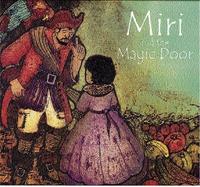
Title: Miri and the Magic Door
Author: Juliet Barclay
Illustrations: Xiomara Sera
Publisher: Macmillan Caribbean
Reviewed by: Siobhan Morrison
Pry open the cover and the magical world of Miri and the Magic Door. Meet Miri, a little girl living in the picturesque capital of Cuba. On what seemed like an ordinary day, Miri wakes up to find the mysterious appearance of a 'blue door with rusty hinges' in the wall of her house.
She passes through the door, only to find that she has entered into a different world. It doesn't take her very long to realise that she is still in Havana, just in a different time. She soon comes across a rather unusual pirate and his bad-tempered parrot, Bilioso.
Rather than a sword-swishing devil-may-care pirate, the pirate in the book is a sad, bewildered soul who is clearly ruled by his obnoxious foul-mouthed parrot. Instead of hunting treasure, he is off in search of fruits, and instead of a sword he has a rusty cutlass. Running low on 'booty' and inept when it comes to escaping capture by the Spanish soldiers, he turns to Miri. Although she knows that pirates are bad she feels sorry for him. Thus begins Miri's adventure into the life of a buccaneer.
The book is a fun look into the cultural history of Cuba. And like the rest of the Caribbean, Cuba's history is rich and diverse. The largest and richest of the Caribbean island, Cuba remained a Spanish colony until 1902 when they won independence.
During the early days of colonisation Cuba, like Jamaica, was a target for pirate and buccaneers looking for a place to hide their treasure, as well as an opportunity to partake of Spain's riches and to influence the secured trade between Cuba and Jamaica. Forts, like those seen in the book, were built in the port towns of Havana and the old capital Santiago de Cuba to protect the island.
History of havana
Juliet Barclay, who previously worked as the head of design for the Directorate of Cultural Heritage and the Office of the City Historian of Havana, incorporates her artistic skill with her knowledge of Cuban history in a way that is both understandable and entertaining to her audience, who may range from three years and older.
In just a few pages and a deceptively simple style, Barclay takes her young readers on a journey through time. She traverses between present-day Havana, with its rich mystic beauty, and the swashbuckling pungent era of old Cuba. We are immersed in the muted danger and decaying environment of the era the minute Miri steps through the magic door. But one that is also fun and filled with adventure, as she outwits soldiers, and sets sail on the open waters of the Caribbean Sea - both hands at the helm.
There are several things I like about this book. The first is its overall look. It is bound in hardcover - making it durable, especially for the pre-school audience - this 57-page book is a visual feast from cover to cover. The illustrations on each page are like mini paintings, rather than clean, careful computer-generated designs.
Then there is the plot, which moves fluidly and rhythmically from beginning to end. Barclay uses lots of descriptive words, personification and end rhymes to paint a mental picture that will appeal to all the senses, and her characters are unique.
Have fun with your kids on the other side of Miri and the Magic Door!

